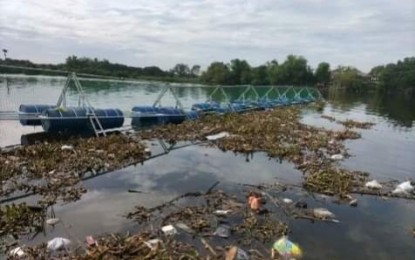
TRASH TRAPS. More than 124 tons of solid wastes have been collected from 125 floating trash traps since these were installed in 2020 in the critical water bodies of Bataan, Bulacan and Pampanga by the DENR Regional Office 3. The floating trash traps were made from recycled materials such as plastic and old fishing gears. (Photo courtesy of DENR-3)
CITY OF SAN FERNANDO, Pampanga – More than 124 tons of solid wastes have been collected since last year from 125 floating trash traps installed in critical water bodies of Bataan, Bulacan and Pampanga by the Department of Environment and Natural Resources (DENR) regional office here in an effort to clean and save the Manila Bay.
Paquito Moreno Jr., executive director of the DENR-Central Luzon, on Monday said the trash traps were strategically installed in rivers and streams to reduce the volume of solid wastes directly flowing to the greater portion of the Manila Bay.
"In addition to our cleanup efforts, we heighten our efforts to curb wastes and floating debris in our local waterways by putting up these recyclable trash traps," he said in an official social media post.
The floating trash traps, which are made from recycled materials such as plastic and fishing gear and measuring about 30 to 100 meters, were put up last year in Lamao, Orani, Orion, Pinulot, Pangulisanin, Amo, Aguawan, Almacen, Bilolo, Talisay, Mabuco and Samal rivers, all in Bataan, and Guagua-Pasak River in Pampanga.
As a mitigation strategy, Moreno said the trash trapping initiative has reduced the volume of plastic wastes in water bodies and prevented single-used plastics, candy wrappers, containers, and other pollutants from entering waterways and flowing downstream, since solid wastes were captured directly from their source.
The DENR official assured the public that the trash traps in local waterways do not hamper the movement of fishes and other aquatic species, but protect physical habitats and coastal and marine ecosystems from being polluted.
Since the Manila Bay rehabilitation program started in January 2019, more than 4,300 tons of biodegradable, residual, recyclable, and hazardous wastes have been collected in Central Luzon.
Moreno reiterated his appeal to the public to support the DENR in its campaign to save Manila Bay and to religiously practice the 3Rs (reduce, reuse and recycle) of solid waste management coupled with discipline to reduce waste generation in the region.
He said it is the commitment of the DENR and the rest of the mandamus agencies to the public to clean Manila Bay, which covers Calabarzon, the National Capital Region and Central Luzon, which have a total of 190 kilometers of coastline.
Of the number, 144 kilometers are part of Central Luzon, covering the provinces of Bulacan, Pampanga, and Bataan.
Meanwhile, statistics from the DENR's Environmental Management Bureau-Region 3 showed that the average solid waste generation of Central Luzon is estimated to be 5,598 tons per year. (PNA)
